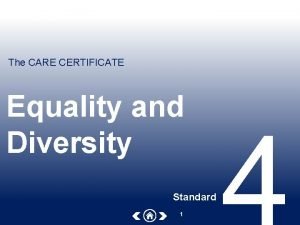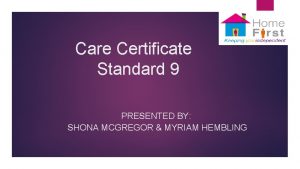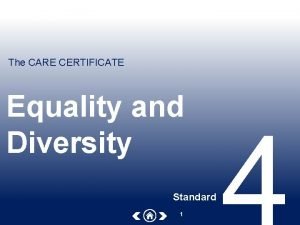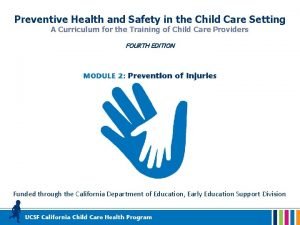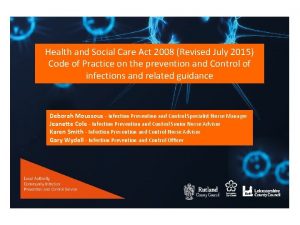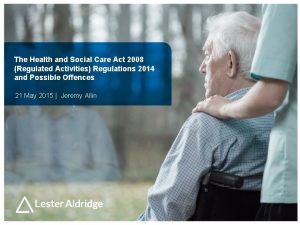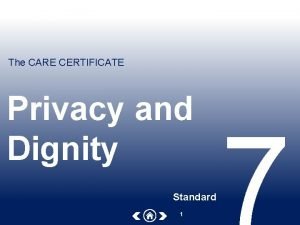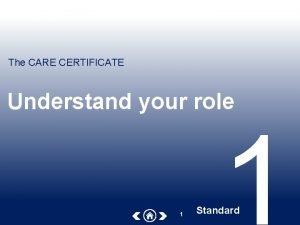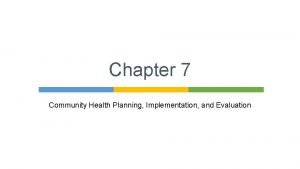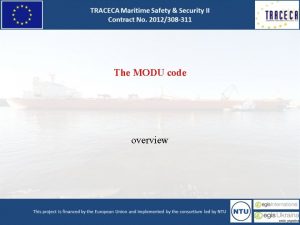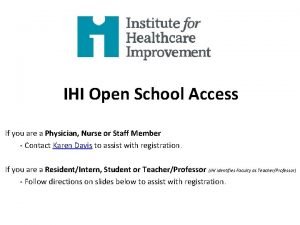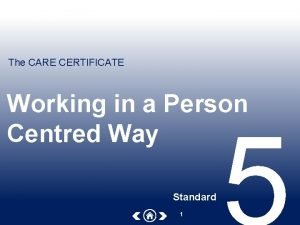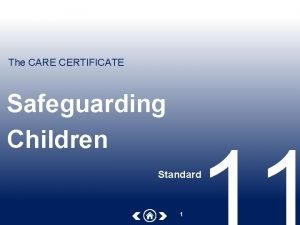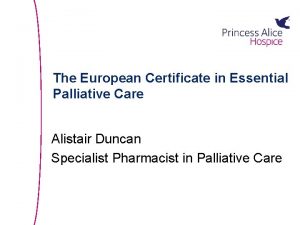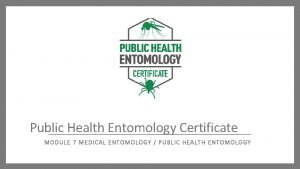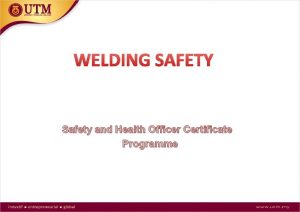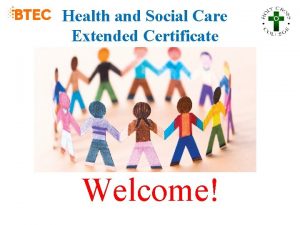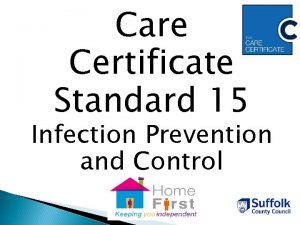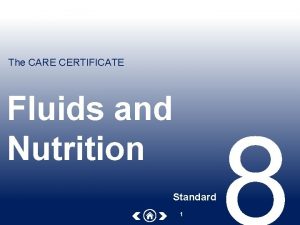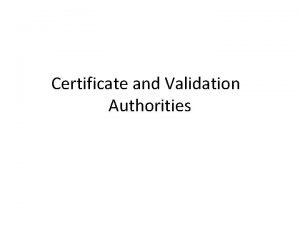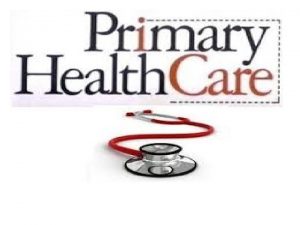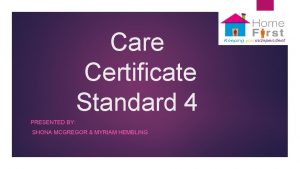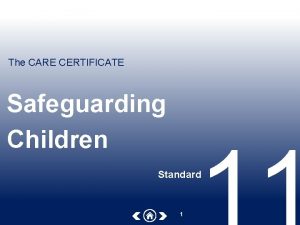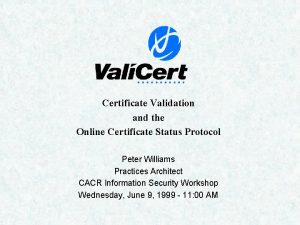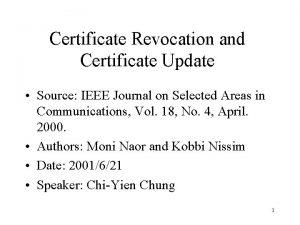The CARE CERTIFICATE Health and Safety Standard 1





















- Slides: 21

The CARE CERTIFICATE Health and Safety Standard 1

Learning outcomes 13. 1 Understand their own responsibilities, and the responsibilities of others, relating to health and safety in the workplace 13. 2 Move and assist safely 13. 3 Understand procedures for responding to accidents and sudden illness 13. 4 Understand medication and healthcare tasks 13. 5 Handle hazardous substances 13. 6 Promote fire safety 13. 7 Work securely Standard 13. 8 Manage stress. 2

Health and safety laws aim to protect people that work and those affected by work. Key pieces of health and safety legislation include: ■ Health and Safety at Work etc. Act 1974 ■ Reporting of Injuries, Diseases and Dangerous Occurrences Regulations 2013 (RIDDOR) ■ The Management of Health and Safety at Work Regulations 1999 ■ The Regulatory Reform (Fire Safety) Order 2005 ■ Control of Substances Hazardous to Health Regulations (COSHH) 2002 ■ The Manual Handling Operations Regulations 1992 ■ The Provision and Use of Work Equipment Regulations 2002 ■ The Lifting Operations and Lifting Equipment Regulations 1998 (LOLER). 3

Policies and procedures Most employers have a health and safety policy. This tells everyone how to do something or what must be in place to make sure all people are safe. Examples of policies include: How to store and give out medication How to provide personal care How to lift and carry loads What to do in the event of fire What to do to provide first aid How to handle soiled bed linen. 4

Health and safety responsibilities Responsibilities in the workplace: Employees All employees, including health and social care workers, must take reasonable care of themselves and others in the workplace. Workers must follow their employer’s policies and procedures and not act in ways that could cause an accident or ill health to themselves or to others. Employers must ensure the health, safety and welfare of all employees. They have a responsibility to provide; a safe place to work, necessary training and appropriate and safe work equipment. Others in the workplace Everyone in the workplace should avoid any actions that could potentially harm others, act respectfully and not cause any damage to property. 5

Training Some activities must not be carried carry out until you are trained and assessed as competent. These activities include: ■ Use of equipment such as hoists and lifts ■ Medication ■ Assisting and moving ■ First aid ■ Emergency procedures ■ Food handling and preparation. Competence To make sure that you are keeping the individuals you support as safe as possible, you should only undertake certain activities once you are competent to do so. 6

Additional support and information If you want to know more about how to prevent accidents or ill health there are many sources of support and information, including: ■ Your manager or supervisor ■ Policies and procedures ■ The designated health and safety person in your workplace ■ Health and safety leaflets and posters ■ The Health and Safety Executive (HSE) website. 7

Accidents that may happen depend upon the risks found in the particular workplace. Examples of accidents that could happen in a health or social care workplace: Slips and trips Falls Sharps injuries Accidental poisoning Electrocution Burns and scalds Injuries from machinery/equipment 8

Sudden illness Some of the individuals you provide care and support for may have existing conditions which can cause sudden illness situations including: Diabetic coma Epileptic seizure Food poisoning Burns Fainting Bleeding Shock Choking Fractures Stroke Heart attack An individuals’ care or support plan will identify known conditions and how to respond if they become ill. 9

First aid ■ To be able to administer first aid you must attend specialist training and be assessed as competent ■ If you have not been trained in first aid you should seek help immediately; you could make the person’s condition worse if you attempt first aid without proper training. 10

Risk assessment ■ Risk assessments identify hazards, evaluate the level of risk and put in place measures to reduce the risk ■ If you identify a risk you must tell your manager or supervisor ■ You should follow agreed ways of working for reporting health and safety risks. Hazards This is something with the potential to cause harm. For example soiled bed linen or clothing, spillages of bodily fluids and assisting people to move. Risk The likelihood of the hazard causing harm. For example picking up an infection from soiled bed linen, slipping on fluids from spillages or trapping injuries from using a hoist. 11

Moving and assisting You may be required to assist people to move or to move objects. Activities that require training include: ■ Using equipment to move people ■ Supporting an individual to transfer from a bed to a chair ■ Helping with daily routines like bathing ■ Moving on and off the toilet You must always work in the agreed ways found in your policies and procedures and the individual’s # care plan. 12

Medication and healthcare activities ■ Individuals may need assistance with activities including filing fingernails or toe nails, continence maintenance and assisting with medication ■ As a rule you should not carry out any actions that are not covered by the individual’s care plan. 13

Hazardous substances can cause harm if they are breathed in, swallowed, injected or absorbed. Examples that can be found in a health and social care environment include: Cleaning materials Body fluids Clinical waste such as dressings Disinfectants Medication Contaminated bed linen. 14

Fire safety measures will depend on where you work. Basic fire prevention measures include: ■ No smoking or naked flames within the building ■ Do not have fire doors propped open ■ Do not allow waste to accumulate ■ Ensuring that escape routes are not blocked ■ Turning off appliances where possible. 15

Working safely and securely In order to prevent individuals from becoming victims of crime, good security measures are important. Examples of security measures: ■ Challenging any strangers in restricted areas. ■ Requiring visitors to sign a visitor book ■ Setting alarms where they are fitted ■ Checking the identity of individuals Security procedures will depend on the organisation you work for. You must always work in agreed ways. 16

Stress is the adverse reaction people have to excessive pressures or demands placed upon them. Signs of stress can be: Psychological or emotional Physiological or physical Behavioural ■ ■ ■ ■ ■ Heart palpitations ■ Stomach complaints such as irritable bowel syndrome ■ Uneasiness ■ Tension ■ ■ Anxiety Anger Depression Low self-esteem Feeling helpless Tearfulness Irritability Indecisiveness 17 Aggression Substance misuse Sleeping more or less Changes in eating patterns ■ Changes to mood ■ Changes to behaviour.

Managing stress well can reduce the negative effects on others including the individuals you provide care and support for, the people you work with, your family and friends. Helpful strategies to deal with stress include: ■ ■ ■ Taking more exercise Removing yourself from a situation and taking time out Talking through how you feel with your line manager Eating a healthy diet Not smoking or drinking excessively. 18

Knowledge check Which of the following tasks should not be undertaken without specific training? Click to reveal answer Supporting people to eat and drink Assisting people to take part in activities Supporting people to communicate Using equipment such as hoists and lifts 19

Knowledge check Which of the following answers best describes an employee’s health and safety responsibilities in the workplace? To take reasonable care of their health and safety and that of others To write health and safety policies and procedures To carry out inspections in the workplace To carry out risk assessments and identify control measures 20 Click to reveal answer

Knowledge check Which of the following pieces of legislation relates specifically to moving and assisting? Click to reveal answer Health and Safety at Work etc. Act 1974 Control of Substances Hazardous to Health Regulations 2002 Lifting Operations and Lifting Equipment Regulations 1998 Reporting of Injuries, Diseases and Dangerous Occurrences Regulations 2013 21
 Care certificate standard 8 answers
Care certificate standard 8 answers Equality and diversity care certificate
Equality and diversity care certificate Care certificate standard 3
Care certificate standard 3 Care certificate 9
Care certificate 9 Care certificate equality and diversity
Care certificate equality and diversity Health and social care component 3 health and wellbeing
Health and social care component 3 health and wellbeing Preventive health and safety in the child care setting
Preventive health and safety in the child care setting Health and social care act 2008
Health and social care act 2008 Health and social care act 2008
Health and social care act 2008 Qbs safety care
Qbs safety care Health and social care values unit 2
Health and social care values unit 2 Hip fracture clinical care standard
Hip fracture clinical care standard Primary care secondary care tertiary care
Primary care secondary care tertiary care Standard 7 privacy and dignity
Standard 7 privacy and dignity Care certificate and code of conduct standards include
Care certificate and code of conduct standards include Community health planning and implementation
Community health planning and implementation Modu code
Modu code Ihi open school basic certificate in quality & safety
Ihi open school basic certificate in quality & safety Care certificate 5
Care certificate 5 Safeguarding children care certificate
Safeguarding children care certificate European certificate in essential palliative care
European certificate in essential palliative care Public health entomology certificate
Public health entomology certificate

